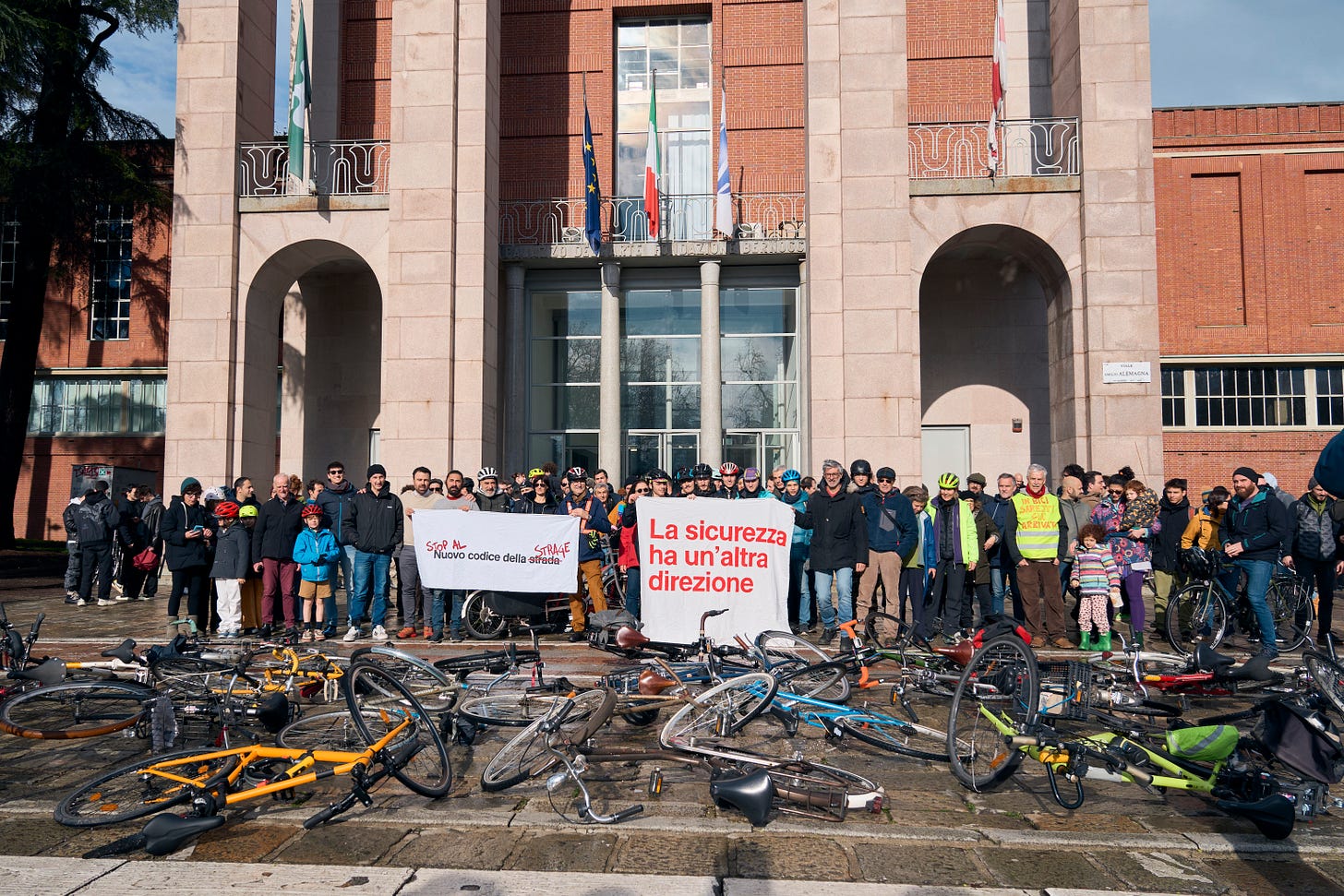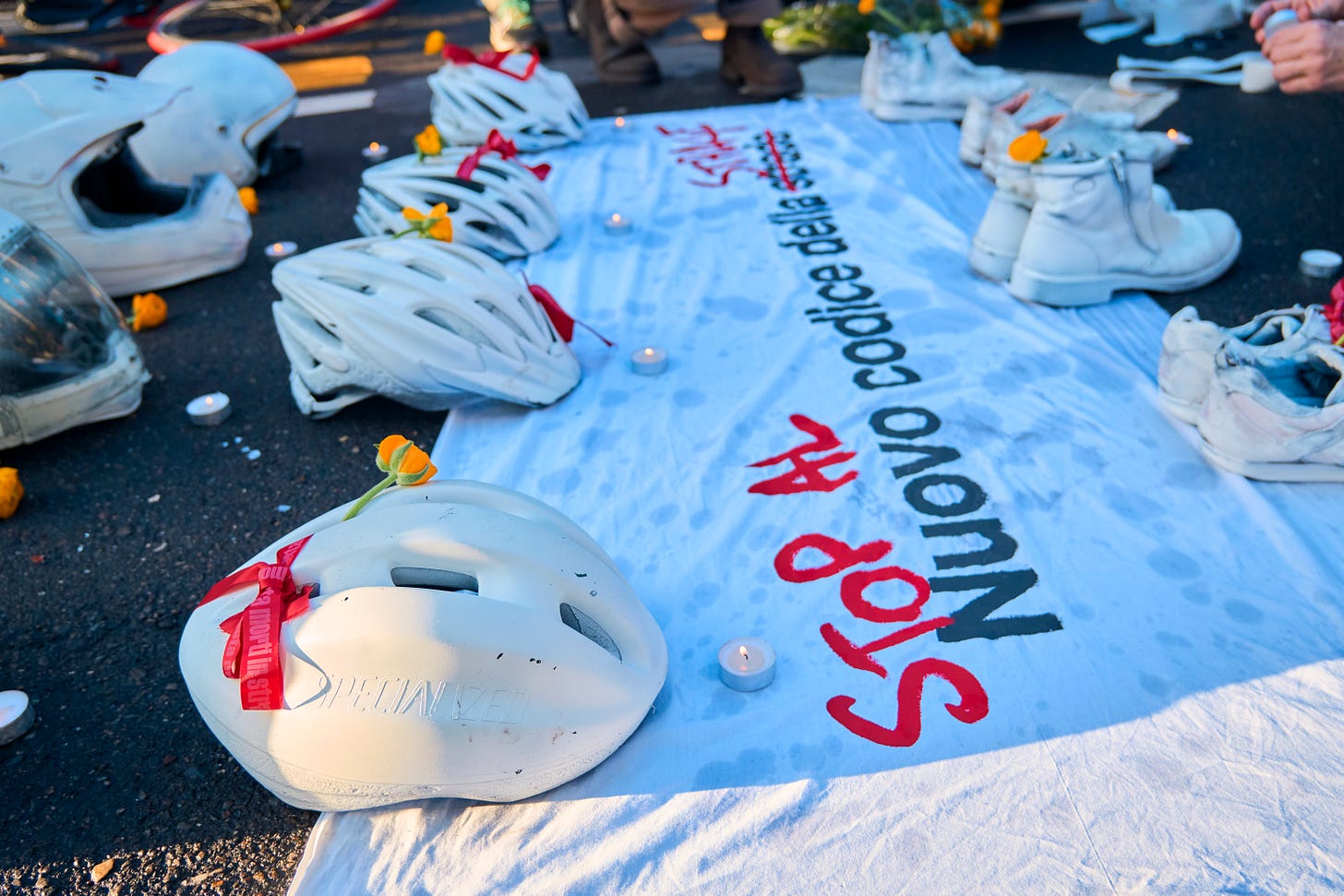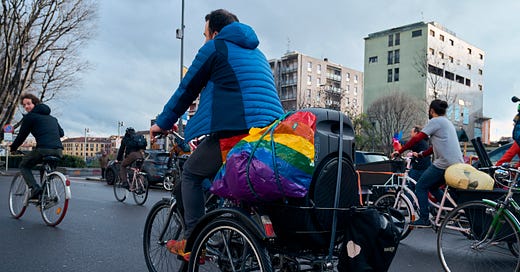“The best cycling policy is a car policy” - the wise words of our CEO Meredith Glaser are the ironic truth of any policy making for cycling cities. Today we deep-dive into the situation in Italy, where this truth is turning ugly. In this case you could say that, the best car policy is the worst cycling policy…
Michela Grasso - researcher at the Urban Cycling Institute, and founder/writer at Spaghetti politics, brings her perspective on the new Italian traffic code.
We would like to express our deep gratitude for your support in advancing our mission. Your membership makes it possible for us to create quality content and nurture the global cycling community. A big Thank You 🙏
Italy, the sunny Mediterranean country where between an afternoon on the beach and a sip of wine at dinner you might get run over by a speeding car driver. It might seem like an exaggeration, but this is the reality in Bel Paese, where more than 456 road accidents happen on a daily basis.
In 2023 alone, 3039 people lost their lives - 8 people per day - 23% of whom were “vulnerable road users” (cyclists and pedestrians). A staggering 94% of those accidents were the responsibility of the car driver.
Despite these tragic incidents the Italian government recently approved a new traffic code destined to worsen the already dire situation by green-lighting car-centricity and endangering cyclists and pedestrians.
Quando il gatto non c'è, i topi ballano
(When the cat's away, the mice dance - Italian folk proverb)
In 2024, an anonymous and masked vigilante, known as “Fleximan”, started destroying speed cameras in northern Italy. He acted in secret, leaving behind a trail of destroyed autovelox (a device used by the Italian police to catch drivers exceeding the speed limit).
In the end, Fleximan turned out to be a group of people dedicated to the destruction of speed-checking systems, and all the members were arrested by the summer. Nonetheless, the “anonymous vigilante” was hailed as a hero by many (not a surprise in a country where speed is still seen as admirable and “badass”), and the government began to embrace the Fleximan spirit.
In the new set of laws, traffic monitoring has been heavily reduced, for the happiness of many car drivers throughout the country:
Speed cameras will not be allowed in areas where the speed limit is below 50 km/h, except for a few specific cases. This means that in cities with a 30km/h speed limit, such as Bologna, it will not be possible to control, and therefore fine, those who exceed the limit.
Speed cameras can only be installed on roads that have shown a high number of road accidents in the previous 5 years.
One fine for all: if on the same road, within the same hour, you commit multiple speed violations; you will be only fined for one of these violations and not for the others. For example, if on the highway between Milano and Bergamo, there are 6-speed cameras and a car speeds through the entire road, the driver will only receive one fine (for the most severe violations of the 6).
The installation of new speed-checking systems is made increasingly difficult and needs to respect a new series of requirements that, when not respected, will lead to the cancellation of the fine.
In fact, Italy has the highest number of speed-checking systems in the European Union, 11,300, making them the sworn enemy of many Italian motorists. For comparison, Germany counts 4,700, and France 3,700. This is for a good reason, considering that speed is the number one cause of road accidents in Italy, injuring and killing thousands of people every year. Removing one of the few deterrents to excessive speed is a recipe for disaster.
Italian motorists’ hatred for speed cameras stems from the misconception that they are a government tool to “make money” through fines, and it is easy to appease car drivers by ensuring they can exceed speed limits without any consequence. However, while the mice dancing when the cat's away might not cause major inconveniences, a car speeding when the speed camera is gone will have devastating consequences.

Do Cyclists' Lives Matter?
The approach of the current government to cycling has never been favorable, but it seems that new depths can always be reached and the new traffic code is not short of absurd dispositions to regulate cycling behavior and dispense car drivers from caution:
It is mandatory to overtake a cyclist at a distance of 1.5 meters, only where the conditions of the road allow it.
Limitation on the creation of cycle lanes. The new code limits the creation of “unprotected lanes” (lanes that are painted on the road and not physically separated from cars). They will only be allowed where strict separation is not possible, but the process of verification (which needs to be done by multiple entities, and not only by the municipality itself), is lengthy and does not guarantee the creation of any of the two.
Plenty of norms will restrict the construction of easy and cheap security systems for cyclists (such as using road painting on urban roads to signal the presence of bikes, bike boxes at crossroads, etc..).
At first sight, the new traffic code does not expressly limit cycling, but looking deeper it is possible to see the nuances. For example, it takes a lot of decision-making power away from municipalities, assigning it to officials who are not familiar with the difficulties and peculiarities of specific environments and situations. As a consequence, processes become longer, more expensive, and less efficient.
Tommaso Goisis, one of the faces of cycling activism in Milano, is particularly concerned about the impact that the new traffic code will have on cyclists. “The new traffic code is setting up the stage for a disaster”, he tells the Urban Cycling Institute “For example, look at the rule that states “It is mandatory to overtake a cyclist with a distance of 1.5 meters, only where the conditions of the road allow it.”, what does it even mean? This might seem positive, but it can only be applied when the conditions of the roads allow it, and what are those conditions? And when those conditions don’t exist, can the car just overtake me at 10 cm? The government should have gotten inspiration from other countries, where cars cannot overtake cyclists unless there are very specific conditions, and when those conditions don’t exist, the car simply has to wait”.
In past months, exponents of municipal and regional governments throughout the country felt emboldened in expressing their (unwanted) opinions on cyclists, from saying “I only like cyclists when they get run over” (Vittorio Feltri, regional councilor of Region Lombardia), to “Cyclists are responsible for being run over by trucks” (Paolo Roccatagliata, Councilman of Milano). Hatred towards vulnerable road users is unfortunately common in plenty of countries, but it seems to be particularly vicious in Italy, where politicians can openly joke about the deaths of a part of their citizens, without any consequences.
“Urban cyclists represent a threat for many people” explains Tommaso, “They represent an alternative to the auto-capitalist system. For this reason, they are called lazy, not taken seriously, and are seen as people who do not work as hard as others (those who drive), but despite the efforts to reduce our presence and credibility, our numbers are increasing.”

Looking in the Devil’s Pots
The new traffic code did not go unnoticed and raised plenty of criticism throughout the country. Tommaso took part in multiple protests and actions against the new traffic code. He recounts, “It was quite extraordinary and unique, despite starting too late and with zero resources. We have been able to gather people from the whole country, and the relatives of road victims have been leading the way, together with environmental organizations and unions. Perhaps something like this should have happened years ago, but better late than never, now we have a network that can take matters into its own hands and seriously start advocating for different roads. I see this mobilization as the embryo of future change.”
As we say in Italian, ‘Il Diavolo fa le pentole ma non i coperchi’ (the devil makes pots but not lids), meaning that lies, and in this case, propaganda, cannot be covered up for long. The mobilization against the traffic code that has been taking place since the beginning of 2024 in more than 40 Italian cities is proof that tens of thousands of people have seen the real aim of these new laws: appeasing car-drivers and the automotive industry, by proposing conservative and populist measures that will bring safety on Italian roads to a historic low.
Written by Michela Grasso
Sources:
Incidenti stradali in Italia – 2023 – Istat
Il mito tossico della velocità dietro al dramma irrisolto della violenza stradale - Linkiesta.it







